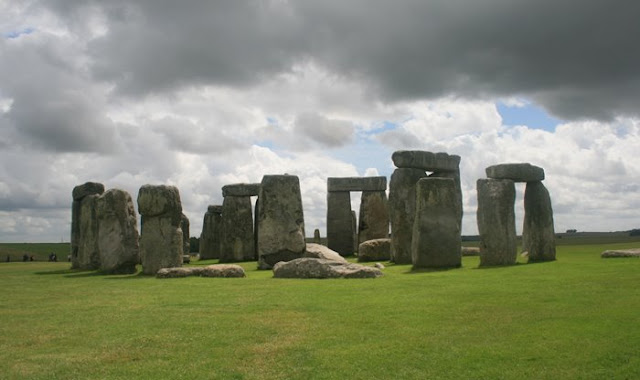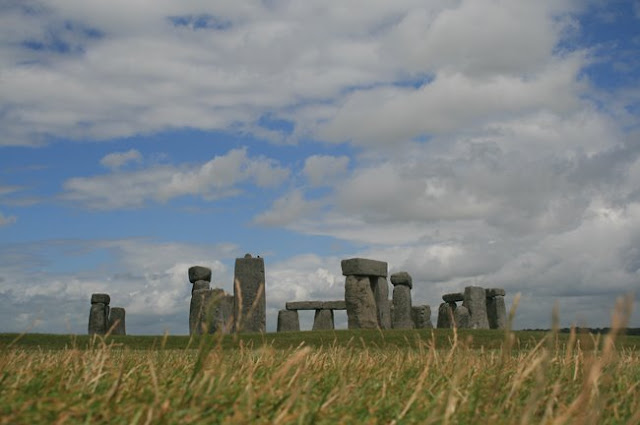
Stonehenge está ubicado en una llanura del condado de Wiltshire (Salisbury) y es, sin duda, el monumento prehistórico más famoso de Europa. Con sus 5.000 años de antigüedad, ha sabido rodearse de un halo de misterio y a pesar de los numerosos estudios que se han hecho sobre las piedras, aún no se sabe con certeza qué utilidad se les dio, el porqué de su construcción. Se manejan diversas hipótesis del tipo: lugar de sacrificio a los dioses, culto sacerdotal, determinar los cambios de estación... Dejando atrás Brighton, en la comarca de Las Downs y la Costa del Canal, nos adentramos en la región de Wessex buscando esas piedras “mágicas” milenarias que tanto han dado que hablar y que han sido protagonistas de libros y películas por doquier. Es una sensación extraña la que te embarga cuando estás allí de pie observándolas, porque no hay nada a su alrededor más que una vasta extensión de campo adornado con ovejitas dispersas que te recuerdan que otro de los atractivos de la región es el queso cheddar, tan sabroso, que se te pega al paladar. Lo cierto es que cada piedra pesa de dos a treinta y cinco toneladas y están llenas de mitos y leyendas. En los auriculares que nos dieron hablaban de varias.
Estas son las que más me sorprendieron:
- Las piedras las llevó hasta allí, en unos artefactos especiales para la ocasión y desde Irlanda, el Mago Merlín. De este modo, conmemoraba un entierro masivo de bretones.
- Fue un templo construido por los druidas -antiguos sacerdotes celtas- para ofrecer sacrificios humanos a sus dioses. Incluso bautizaron como “piedra del altar” a una que está caída en el centro del complejo. Más tarde se descubriría que el complejo megalítico llevaba allí dos mil años antes de que llegaran los druidas.
Parece que lo más razonable sería creer que el estudio de las estrellas era el motivo real de esta construcción que se hizo a lo largo de 40 generaciones, según los estudiosos. La estructura del monumento está formada por varios círculos. Uno exterior del que quedan 17 columnas rectangulares, de las 30 originales, coronadas por 6 dinteles. Son piedras de gres silicio que tienen un color amarillento. Le sigue otro a 3 metros, formado por 20 menhires ( bloques de piedra verticales que en principio eran 60 ) de roca azul, muy dura y originaria de Gales. Después, otra fila de piedras de gres silicio en forma de herradura unidas de dos en dos por otra horizontal ( 5 bloques en total ) y la composición más grande es la del centro. Dentro de esta “herradura” hay 19 monolitos verticales de piedra azul para finalizar con la piedra central llamada “piedra del altar” que está tendida en el suelo actualmente y como es de arenisca verde, adquiere un aspecto muy brillante cuando le da el sol.
Fuera del conjunto hay un foso circular que contiene, además de las piedras, una serie de cavidades en la tierra, otros dos monolíticos y la “piedra talón”, justo enfrente de la del altar. Sea lo que sea que allí ha ido sucediendo a lo largo de los siglos, lo cierto es que el lugar tiene algo de “paranormal” aunque no sabría decir si por su propia naturaleza o por el empeño común, transformado en energía, de que algo sobrenatural se gestó en su construcción y se ha ido transmitiendo a las generaciones posteriores... irremediablemente.
** More pics and videos / Mas fotos y vídeos en mi Instagram **
Leaving Brighton behind, in the region of The Downs and the Coast of the Channel, we enter Wessex's region looking for these "magic" thousand-year-old stones that so much have given to speak and that have been protagonists of books and movies everywhere. You come closer driving and from off you see them, of foot in a plain of Wiltshire's county (Salisbury), and already you put of the nerves. It is a strange sensation because there is nothing around it any more than a vast extension than field adorned with sheeps attacked like dispersed spots that remind you that one of the attractions of the region it is the cheese cheddar, so tastily, that stick you to the palate. Stonehenge is, undoubtedly, the most famous prehistoric monument of Europe. With more than 5.000 years of antique, it has surrounded itself with a halo of mystery and in spite of the numerous studies that have been done on the stones, there still isn´t known by certainty what utility was given to them, and why of its construction. There are diverse hypotheses of the type: place of sacrifice to the gods, priestly worship, to determine the changes of station... The certain thing is that every stone weighs from two to thirty-five tons and they are full of myths and legends. In the earphones that gave us they were speaking about several.
These are those that I most surprised:
· The stones were placed even there, in a few special appliances for the occasion and from Ireland, by Merlin The Magician. Thus, he was commemorating a Bretons' massive burial.
· Was a temple constructed by the Druids - former Celtic priests - to offer human sacrifices to theirs gods. Even they baptized as "stone of the altar" one that is fallen in the center of the complex. Later there would be discovered that the megalithic complex was going there two thousand years before the Druids were coming.
It seems that the most reasonable thing would be to believe that the study of the stars was the real motive of this construction that was done along 40 generations, according to the experts. The structure of the monument is formed by several circles. One exterior of which 17 rectangular columns stay - of the 30 original - crowned by 6 lintels. They are stones of sandstone silicon that they have a yellowish color. It follows other one to 3 meters, formed by 20 megaliths - vertical blocks of stone that at first were 60- of blue, very hard and original rock of Wales. Later, another row of stones of sandstone silicon in the shape of "horse-shoe" joined of two in two for horizontal other one - 5 blocks in whole - and the biggest composition is that of the center. Inside this "horse-shoe" there are 19 vertical monoliths of blue stone to finish with the central so called: "stone of the altar" that is stretched in the soil nowadays and since it is of green sandstone, acquire a very brilliant aspect when it is sunbathed. Out of the set there is a circular pit that contains, besides the stones, a series of cavities in the land, other two monolithic ones and the "stone heel" - opposite to the altar stone-. Whatever it may be that there has been happening throughout the centuries, the certain thing is that the place has something of "paranormal" though it would not be able say if for its own nature or for the common determination transformed into energy, of which something supernatural was in preparation in its construction and it has been transmitting the later generations ... irremediably.













17 comentarios :
Gracias por pasar por mi blog XD
Stonehenge :O
Nunca he estado pero debe ser precioso, me recuerda a los druidas que aun quedan algunos por cierto. La cultura celta fue la primera que me gusto de pequeño, muy unida a la naturaleza y a los lobos :)
De la ropa de oficina muy interesante pero mejor no me la pongo XD
Besos, cuidate
Precioso Stonehenge, me recuerda a los druidas. La primera cultura que me gusto fueron los celtas. Muy unidos a la naturaleza y adoraban los lobos :)
Me gusta tu blog es una mezcla de viajes :)
Muchas gracias por pasar por mi blog, besos
Si, si, muy misterioso desde luego...
jajajaj no no te la pongas porfa
bss
;-)
Wow! I'd love to see Stonehenge someday!
And that Spy-esque bag is great!
xoxox,
CC
Hi there-thank you so much for a gorgeous commentary and stunning pictures-I'm learning so much through you!!
Gracias por haberte dejado caer por mi rincón. Hey, me ha encantado tu blog... Es genial viajar y las fotos son estupendas, en Stonehenge no he estado, pero en Venecia sí... que preciosidad. En cuanto a la ropa, aunque josevi no se la ponga, yo sí.:-) Un blog de tendencias... mmmm, que bien. Volveré.
Un beso
hola que buen blog tienes, es interesante conocer culturas e historia de otros paises...saludos¡¡¡¡
Hi couturecarrie,
Thanks for your comments! In Italy is easy to find that king of good prize bag. I´ve got another one I´ll show you in another post.
Stonehenge is really interesting to visit!
Kss
;-)
Hi sharon,
It´s wonderful what you say!!! Nice you´re around here reading to me. Thans again!
Kss
;-)
Hola almagriss,
Encantada de tenerte por aquí y vuelve, vuelve cuando quieras.
Venecia es de los lugares con más encanto que he visitado aunque tengo que reconocer que Londres es mi ciudad fetiche, a la que más he viajado. Creo que me quedé enganchada a ella por ser el primer destino fuera de España -bueno, Portugal no cuenta- que hice y solita... Toda una aventura.
Bsits
;-)
Hola glory,
Gracias y sigue "viajando" conmigo cuando quieras
bss
;-)
Hi from Paris my new friend,
thank you very much for your kind words in my Paris street style blog.
All what I want is to humanize fashion by showing that real life is more beautiful than the artificial fashion shows and that real people are more beautiful and generous than anorexic top models.
And the stylish girl you are prove it.
Your visits, your comments, your links on your blogs and your buzz are my best salary.
I’ll do my best to please you again and again.
keep on being a delight for your readers, friends and family.
Cheers from Paris
Kamel
STYLE AND THE CITY . COM – PARIS
my tour guide called the stonehenge a big pile of rocks which was true but just not very appealing then. it was so cold that day.
Hi style and the city,
You really do it since your blog is much elaborated. Congratulations
kss
;-)
Hi savvy mode,
When I was there last july weather was realy cold and windy.
But anyway I worst the pain
xxx
;-)
great blog and cute outfits! thanks for stopping by!
You´re welcome issa
kss
;-)
Publicar un comentario